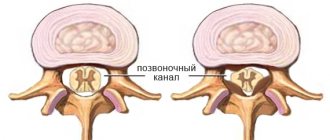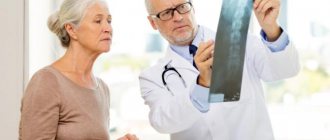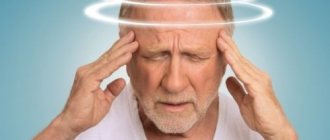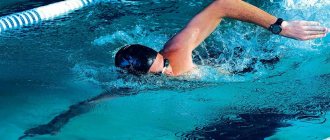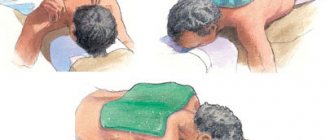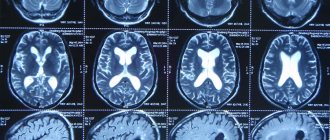Causes of vascular headache development
Vegetative-vascular dystonia is an outdated name for autonomic dysfunction of the cardiovascular system. VSD is characterized by more than 150 symptoms, the most common of which is vascular headache.
The causes of headaches are:
- decreased tone of the blood vessels supplying the brain, which causes hypoxia (usually occurs with a systematic increase in pressure, which stretches the walls of blood vessels),
- pressure on nerve bundles specifically at the moment of a pressure surge (expansion of the walls of blood vessels),
- venous congestion and cerebral edema,
- arterial spasm.
Cervical osteochondrosis, VSD and panic attacks. Treatment.
People with VSD and panic attacks due to cervicothoracic osteochondrosis often do not know where and how it is treated. Patients undergo courses of massage, acupuncture, psychotherapy, take courses of medications, etc. But at best, it only provides temporary relief from the symptoms of muscle tension and panic attacks. It is important to understand that with “cervical osteochondrosis”, VSD and panic attacks, the symptoms of pain in the neck and back are caused by persistent muscle spasm of the deep muscles of the neck, which the massage therapist’s hands cannot reach, and therefore no massage can solve the problem. And the root cause of pain and panic attacks with VSD and “cervical osteochondrosis” will not be eliminated.
Since the cause of muscle pain and panic attacks during VSD is actually not related to cervical osteochondrosis, treatment should be aimed at the nervous system. The impact of the treatment must be quite deep and powerful and at the same time very careful and precise. Among modern methods of traditional medicine, there is a unique technique that meets these requirements - laser treatment: intravenous laser therapy with red or blue lasers and infrared laser therapy of the skin projection of excited autonomic ganglia.
One of the few places that can offer such treatment and where they have been effectively helping to get rid of panic attacks, VSD and “cervical osteochondrosis” for more than 20 years is the Clinical Center for Autonomic Neurology. The clinic's doctors are qualified neurologists-vegetologists who specialize in the treatment of VSD and panic attacks. If you are diagnosed with “cervicothoracic osteochondrosis”, you can contact us, we will conduct a thorough diagnosis of the state of your autonomic nervous system, and treatment will be aimed specifically at eliminating the source of the disease, that is, returning the nervous system to harmonious functioning, which will relieve you of all symptoms cervical osteochondrosis, VSD and panic attacks.
Symptoms of headache with vegetative-vascular dystonia
The symptoms of vascular headaches are very diverse, but the main difference from other types of pain is less intensity, rather “background” pain, but painful attacks, for example, migraines, can also occur.
- Headache with VSD accompanies a person constantly with varying intensity. She goes away during sleep, but returns within the first minutes after waking up. Due to the “background” course of pain, it often begins to be perceived as a normal condition. But if you ask such a patient if he has a headache, he will always answer “yes.”
- The pain with VSD is “dull.” It can be squeezing, bursting, pulsating, etc. Its intensity is low (except for attacks, which are also “dull”, although strong), therefore, if the patient complains of acute pain, this most likely will not be VSD.
- A constant headache slightly disrupts the perception of reality: sounds may seem muffled, the movements of the surrounding world are inhibited and excessively smooth. This condition can be dangerous for a person, as he may inadequately assess the situation and, for example, get hit by a car.
- Vascular headache is often accompanied by other vegetative manifestations and neurological conditions: dizziness, unsteadiness of gait and difficulties with balance and coordination of movements, fainting, drowsiness, weakness, nausea, tinnitus, “stars” before the eyes, increased sweating (especially of the palms).
- The pain may intensify when bending over, which once again proves its vascular origin.
- The localization can be absolutely any: the entire head, one half of the head, a “hoop” at the level of the forehead, only the forehead/temples/back of the head/vertex/eye sockets, with irradiation to the ear or neck.
- The nature of the pain is usually aching, squeezing or, conversely, bursting, often pulsating (not necessarily in time with the heartbeat).
- Painkillers are usually ineffective for vascular pain. In some cases, antispasmodics help.
Often, exacerbations of headaches occur during periods of intense and prolonged mental activity, strong emotional stress, physical overload, weather and climate changes, etc. Read more about the causes and symptoms of VSD here.
What helps with headaches with vegetative-vascular dystonia
Vegetative-vascular dystonia, as a rule, is accompanied by headaches when the weather changes or after overwork, from heat or cold. Morning headaches are usually associated with cardiovascular manifestations of dystonia. If a person with VSD wakes up suddenly, by an alarm clock, or abruptly jumps out of bed, he risks developing throbbing pain or heaviness in the head for the whole day. The difficulty is that not everyone is able to find a suitable medicine in these cases. Even with the same diagnosis, the causes of headaches can be different in different people and are determined by the clinical form of autonomic dysfunction. And in order to influence a symptom, you need to understand what causes it.
How do you treat headaches?
Non-steroidal anti-inflammatory drugs are most often used as a treatment for headaches. Simple analgin works great if you have a headache due to ARVI or fatigue. Also, many are helped by drugs that relieve spasms of smooth muscles: No-shpa, Papaverine. For tension headaches and osteochondrosis of the cervical spine, these drugs are often very effective. But what should those who suffer from vegetative-vascular dystonia do?
Conventional “head pills” do not help much with VSD. Even if you manage to relieve the pain for a while, it will soon return again. After all, its cause - autonomic dysfunction - has not gone away. By taking analgin tablet, you simply suppress the symptom without affecting the disorder itself. What is the nature of your dystonia: cardiovascular, psychogenic, asthenovegetative? Next time the pill may not work, and you will look for a new, stronger painkiller, take it more often and in larger quantities. This is a common situation for many, but by doing this you are harming your health.
What will help with headaches with dystonia?
Attempts to get rid of symptoms without an integrated approach to the problem of VSD are ineffective, so medications are needed that will affect the very cause of VSD. Acute pain can be drowned out with painkillers, but at the same time there is no need to forget about the means that will help you forget about the attacks for a long time, means that improve metabolism in the nervous tissue and myocardium, created from amino acids related to the body. The drugs Eltacin® and Glycine are the main ones for the treatment of VSD. By using them simultaneously, you gently and naturally relieve the symptoms of vegetative-vascular dystonia, improving the general condition of the body. Eltacin® consists of glutamic acid, cystine, glycine - amino acids that, under normal conditions, are continuously synthesized in the body. With autonomic dysfunction, this mechanism is disrupted, and the supply of amino acids from the outside can ensure the processes of regeneration and oxidation. Glycine is the main protective amino acid for the nervous system.
Taking Glycine together with Eltacin® is recommended in case of regular headaches due to VSD, especially under conditions of chronic stress and overwork at work.
Diagnosis of headache due to VSD
A headache can occur in many cases and for various reasons, so it is very important to carry out a differential diagnosis of vascular headache:
- magnetic resonance or computed tomography (to exclude tumors, stroke, vascular malformation, consequences of traumatic brain injury, etc.), electroencephalography,
- X-ray of the head and cervical spine (to exclude sinusitis, skull injuries, displacement of the cervical vertebrae),
- vascular doppler,
- neurological examination (palpation of the neck and shoulder girdle, neurological tests),
- blood tests.
If you suffer from frequent headaches, you need to visit a neurologist who will prescribe the necessary tests and select adequate treatment.
VSD and cervical osteochondrosis – what to treat?
Are you worried about neck pain? Against the background of constant pain, have you developed increased anxiety, weakness, tearfulness, insomnia and sensitivity to changes in atmospheric pressure? Or maybe you are already experiencing unexpected attacks of rapid heartbeat, numbness in the arms and legs, panic attacks and other symptoms of VSD and cervical osteochondrosis?
If you come to the doctor with such complaints, then most likely you will be diagnosed with “cervical osteochondrosis” and will be recommended to move more, do exercises, undergo a massage course, and if you have complaints of panic attacks with cervical osteochondrosis, you will definitely be prescribed medication.
In addition, if a person is bothered by the above symptoms, then along with and even instead of a diagnosis of osteochondrosis, the patient may be given VSD (vegetative-vascular dystonia), because the symptoms of the two diseases suspiciously coincide.
If you become the unfortunate owner of both diagnoses, then the number of pills you use will double. But will all these methods help get rid of constant pain and panic attacks with cervicothoracic osteochondrosis? Ultimately, many patients discover that they are “incurable.”
Therefore, before taking medications “for all diseases,” you should ask a number of logical questions: what comes first and what exactly needs to be treated – VSD and panic attacks, or cervical osteochondrosis? Why are the symptoms the same, but the treatment is different? How to distinguish VSD and cervical osteochondrosis? We will try to find answers to all these questions.
Treatment of vascular headache and prevention of VSD
There is no actual treatment for vascular headache, i.e. It is extremely difficult to stop an attack of pain. Therapeutic measures are aimed at increasing vascular tone, restoring normal blood circulation to the brain and improving the functioning of the cardiovascular system. Read more about the treatment of vegetative-vascular dystonia and specifically headaches at the Aximed neurology clinic “here”.
In addition to drug treatment for people suffering from headaches and other symptoms of VSD, Aximed neurologists recommend:
- eliminate stressful situations from your life as much as possible (change jobs, undergo a course of family psychotherapy, etc.),
- maintain a sleep/wake and work/rest schedule,
- stop smoking (this constricts blood vessels and weakens the elasticity of the walls),
- eat a complete and balanced diet,
- Jogging is highly recommended, since in the process the brain is actively saturated with oxygen (which may be lacking due to reduced blood supply to the brain),
- massages (especially the collar area).
Are you plagued by headaches? Consult a neurologist. Vegetative-vascular dystonia can be treated, but the more advanced the case, the longer it will take, and the more likely it is that the pain will return again. Do not delay treatment, because life without pain is much more pleasant.
When and how do signs of dystonia appear?
The tendency to autonomic dysfunction manifests itself in childhood. Children with hereditary dystonia sleep poorly, are often anxious and suffer from night terrors, they find it more difficult to adapt to new conditions and quickly get tired of physical and psychological stress. If such a child is created with favorable conditions in the family, hardened, and regularly added to the diet with vitamins and amino acids, ensure that he gets enough rest and walks in the fresh air every day, then autonomic regulation will be normalized as all systems develop and grow, and the symptoms of VSD in an adult age may not appear at all.
You can be convinced that poor health is a consequence of autonomic dysfunction after a full examination. Many symptoms of VSD are similar to disorders in other pathologies, and it is important not to miss a condition that can be life-threatening.
Manifestations of dystonia are not dangerous, even if you feel very unwell. But if you do nothing for a long time to return autonomic regulation to normal, then you risk losing your health in the future.
The first episodes of crises in VSD are usually associated with severe stress or an age-related crisis. In the future, any minor reason can cause a storm of somatic symptoms, which will not be easy to cope with.


